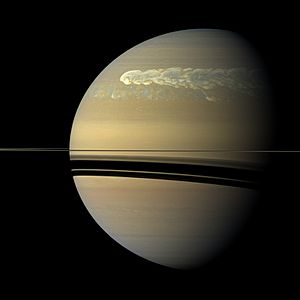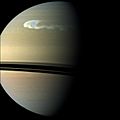Great White Spot facts for kids
The Great White Spot, also called the Great White Oval, is a name for giant storms on Saturn. These storms are so big that we can see them from Earth using a telescope. They look like bright white patches, similar to Jupiter's Great Red Spot.
These spots can be thousands of kilometers wide! Since 2010, a huge band of white clouds has covered Saturn. Scientists call it the Northern Electrostatic Disturbance because it causes more radio and plasma interference. The Cassini spacecraft has been watching this storm. Information from Cassini shows that the white clouds have less acetylene, more phosphine, and a strange temperature drop in the storm's center. In April 2011, the storm got even bigger with a second eruption. Scientists think these white spots are made of ammonia ice. This ice is pushed up by warmer gas from deep inside the planet, breaking through the top layers of Saturn's clouds.
Contents
When Do Great White Spots Appear?
These amazing storms usually happen about every 28.5 Earth years. This is when Saturn's northern hemisphere (the top half) is tilted most towards the Sun. This special time is called the solstice.
Here are some of the times these spots have been seen:
- 1876 – Asaph Hall saw this spot. He used it to figure out how fast Saturn spins, which is called its period of rotation.
- 1903 – Edward Barnard saw this one.
- 1933 – Will Hay, a funny actor and amateur astronomer, spotted this storm.
- 1960 – J.H. Botham from South Africa saw it.
- 1990 – Stuart Wilber saw this spot from September to November.
- 1994 – People on Earth and the Hubble Space Telescope both saw it.
- 2006 – Erick Bondoux and Jean-Luc Dauvergne observed this spot.
- 2010 – Anthony Wesley was the first to see this one.
It's a bit of a mystery why no Great White Spots were recorded before 1876. The 1876 spot was very large and easy to see, even with small telescopes. Maybe people just didn't record them well before then, or perhaps the 1876 spot was truly the first big one seen with telescopes.
What Are Great White Spots Like?
A "classic" Great White Spot is a truly spectacular event. These very bright white storms light up Saturn's usually calm atmosphere. All the major ones have happened in the planet's northern hemisphere.
They often start as smaller, separate "spots." But then, they quickly grow much bigger, stretching out across the planet. The Great White Spots in 1933 and 1990 did this. The 1990 Great White Spot even grew so much that it circled the entire planet!
Images for kids
See also
 In Spanish: Gran Mancha Blanca para niños
In Spanish: Gran Mancha Blanca para niños



